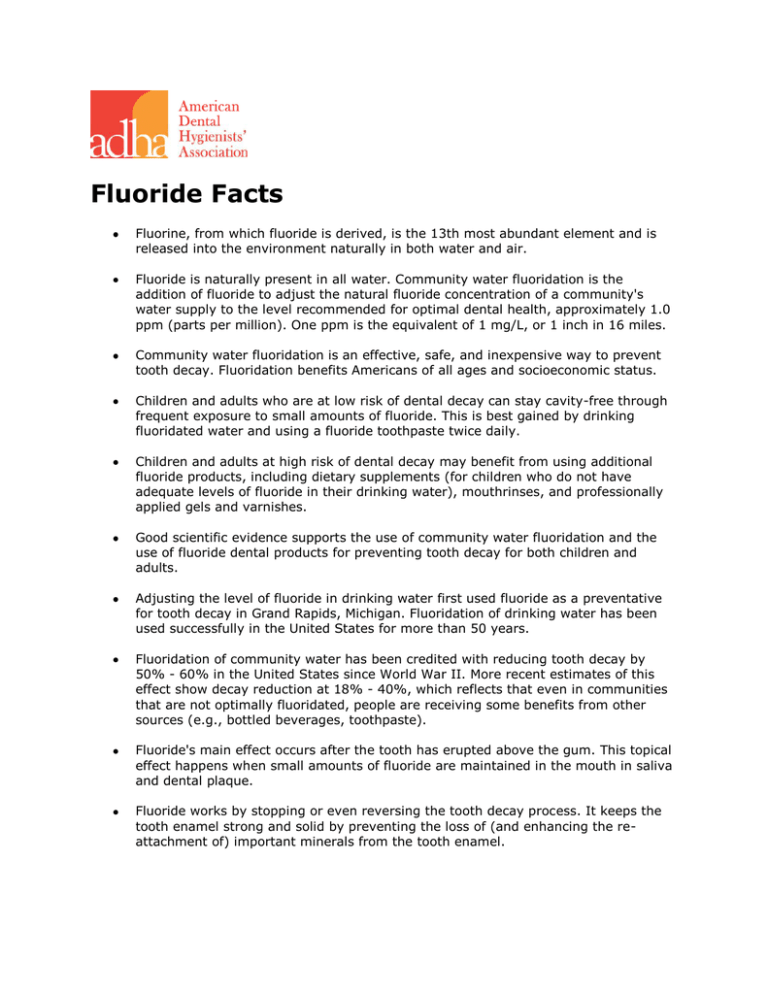Fluoride Facts
advertisement

Fluoride Facts Fluorine, from which fluoride is derived, is the 13th most abundant element and is released into the environment naturally in both water and air. Fluoride is naturally present in all water. Community water fluoridation is the addition of fluoride to adjust the natural fluoride concentration of a community's water supply to the level recommended for optimal dental health, approximately 1.0 ppm (parts per million). One ppm is the equivalent of 1 mg/L, or 1 inch in 16 miles. Community water fluoridation is an effective, safe, and inexpensive way to prevent tooth decay. Fluoridation benefits Americans of all ages and socioeconomic status. Children and adults who are at low risk of dental decay can stay cavity-free through frequent exposure to small amounts of fluoride. This is best gained by drinking fluoridated water and using a fluoride toothpaste twice daily. Children and adults at high risk of dental decay may benefit from using additional fluoride products, including dietary supplements (for children who do not have adequate levels of fluoride in their drinking water), mouthrinses, and professionally applied gels and varnishes. Good scientific evidence supports the use of community water fluoridation and the use of fluoride dental products for preventing tooth decay for both children and adults. Adjusting the level of fluoride in drinking water first used fluoride as a preventative for tooth decay in Grand Rapids, Michigan. Fluoridation of drinking water has been used successfully in the United States for more than 50 years. Fluoridation of community water has been credited with reducing tooth decay by 50% - 60% in the United States since World War II. More recent estimates of this effect show decay reduction at 18% - 40%, which reflects that even in communities that are not optimally fluoridated, people are receiving some benefits from other sources (e.g., bottled beverages, toothpaste). Fluoride's main effect occurs after the tooth has erupted above the gum. This topical effect happens when small amounts of fluoride are maintained in the mouth in saliva and dental plaque. Fluoride works by stopping or even reversing the tooth decay process. It keeps the tooth enamel strong and solid by preventing the loss of (and enhancing the reattachment of) important minerals from the tooth enamel. Of the 50 largest cities in the United States, 43 have community water fluoridation. Fluoridation reaches 62% of the population through public water supplies, more than 144 million people. Water fluoridation costs, on average, 72 cents per person per year in U.S. communities (1999 dollars). Consumption of fluids--water, soft drinks, and juice--accounts for approximately 75 percent of fluoride intake in the United States. Children under age six years may develop enamel fluorosis if they ingest more fluoride than needed. Enamel fluorosis is a chalk-like discoloration (white spots) of tooth enamel. A common source of extra fluoride is unsupervised use of toothpaste in very young children. Fluoride also benefits adults, decreasing the risk of cavities at the root surface as well as the enamel crown. Use of fluoridated water and fluoride dental products will help people maintain oral health and keep more permanent teeth.






